Starbirth Regions
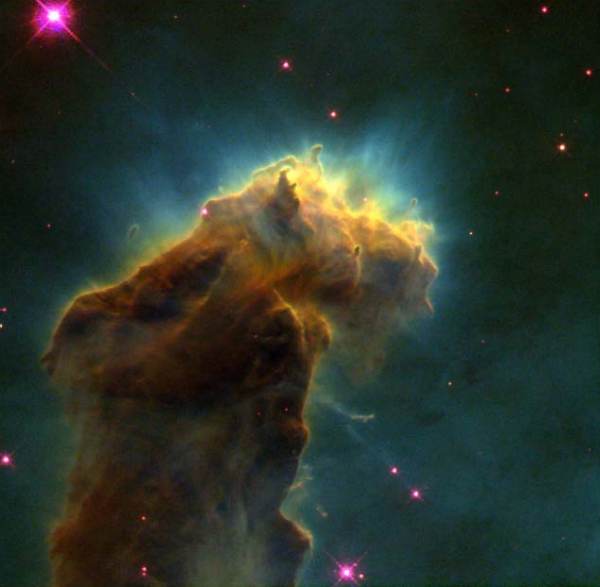
Stellar "Eggs" Emerge from Molecular Cloud
This eerie, dark structure, resembling an imaginary sea serpent's head, is a column of cool molecular hydrogen gas (two atoms of hydrogen in each molecule) and dust that is an incubator for new stars. The stars are embedded inside finger-like protrusions extending from the top of the nebula. Each "fingertip" is somewhat larger than our own solar system.
The pillar is slowly eroding away by the ultraviolet light from nearby hot stars, a process called "photoevaporation". As it does, small globules of especially dense gas buried within the cloud is uncovered. These globules have been dubbed "EGGs" -- an acronym for "Evaporating Gaseous Globules". The shadows of the EGGs protect gas behind them, resulting in the finger-like structures at the top of the cloud.
Forming inside at least some of the EGGs are embryonic stars -- stars that abruptly stop growing when the EGGs are uncovered and they are separated from the larger reservoir of gas from which they were drawing mass. Eventually the stars emerge, as the EGGs themselves succumb to photoevaporation.
The stellar EGGS are found, appropriately enough, in the "Eagle Nebula" (also called M16 -- the 16th object in Charles Messier's 18th century catalog of "fuzzy" permanent objects in the sky), a nearby star-forming region 7,000 light-years away in the constellation Serpens.
The picture was taken on April 1, 1995 with the Hubble Space Telescope Wide Field and Planetary Camera 2. The color image is constructed from three separate images taken in the light of emission from different types of atoms. Red shows emission from singly-ionized sulfur atoms. Green shows emission from hydrogen. Blue shows light emitted by doubly-ionized oxygen atoms.

Hotbed of Star Formation
This is an image of the center of the Omega Nebula, a hotbed of newly born stars wrapped in colorful blankets of glowing gas and cradled in an enormous cold, dark hydrogen cloud. This stunning picture was taken by the newly installed Advanced Camera for Surveys (ACS) aboard NASA's Hubble Space Telescope.
The region of the nebula shown in this photograph is about 3,500 times wider than our solar system. The area represents about 60 percent of the total view captured by ACS. The nebula, also called M17 and the Swan Nebula, resides 5,500 light-years away in the constellation Sagittarius.
Like its famous cousin in Orion, the Swan Nebula is illuminated by ultraviolet radiation from young, massive stars, located just beyond the upper right corner of the image. Each star is about six times hotter and 30 times more massive than the Sun. The powerful radiation from these stars evaporates and erodes the dense cloud of cold gas within which the stars formed. The blistered walls of the hollow cloud shine primarily in the blue, green, and red light emitted by excited atoms of hydrogen, nitrogen, oxygen, and sulfur. Particularly striking is the rose-like feature, seen to the right of center, which glows in the red light emitted by hydrogen and sulfur.
As the infant stars evaporate the surrounding cloud, they expose dense pockets of gas that may contain developing stars. Because these dense pockets are more resistant to the withering radiation than the surrounding cloud, they appear as sculptures in the walls of the cloud or as isolated islands in a sea of glowing gas. One isolated pocket is seen at the center of the brightest region of the nebula and is about 10 times larger than our solar system. Other dense pockets of gas have formed the remarkable feature jutting inward from the left edge of the image, which resembles the famous Horsehead Nebula in Orion.
ACS made this observation on April 1 and 2, 2002. The color image is constructed from four separate images taken in these filters: blue, near infrared, hydrogen alpha, and doubly ionized oxygen.
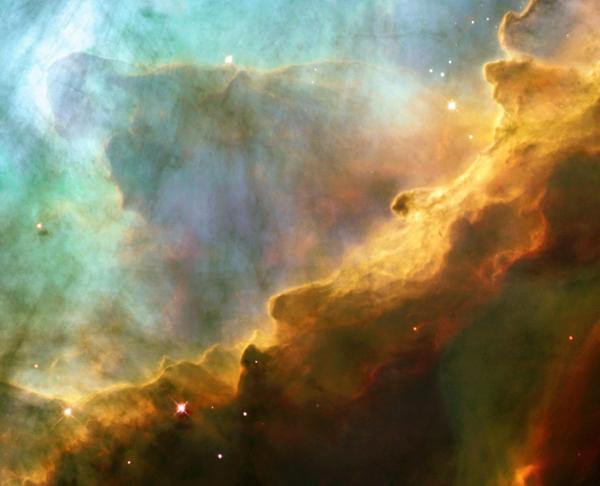
A Perfect Storm of Turbulent Gases
Resembling the fury of a raging sea, this image actually shows a bubbly ocean of glowing hydrogen gas and small amounts of other elements such as oxygen and sulfur.
The photograph, taken by NASA's Hubble Space Telescope, captures a small region within M17, a hotbed of star formation. M17, also known as the Omega or Swan Nebula, is located about 5,500 light-years away in the constellation Sagittarius. The image is being released to commemorate the thirteenth anniversary of Hubble's launch on April 24, 1990.
The wave-like patterns of gas have been sculpted and illuminated by a torrent of ultraviolet radiation from young, massive stars, which lie outside the picture to the upper left. The glow of these patterns accentuates the three-dimensional structure of the gases. The ultraviolet radiation is carving and heating the surfaces of cold hydrogen gas clouds. The warmed surfaces glow orange and red in this photograph. The intense heat and pressure cause some material to stream away from those surfaces, creating the glowing veil of even hotter greenish gas that masks background structures. The pressure on the tips of the waves may trigger new star formation within them.
The image, roughly 3 light-years across, was taken May 29-30, 1999, with the Wide Field Planetary Camera 2. The colors in the image represent various gases. Red represents sulfur; green, hydrogen; and blue, oxygen.
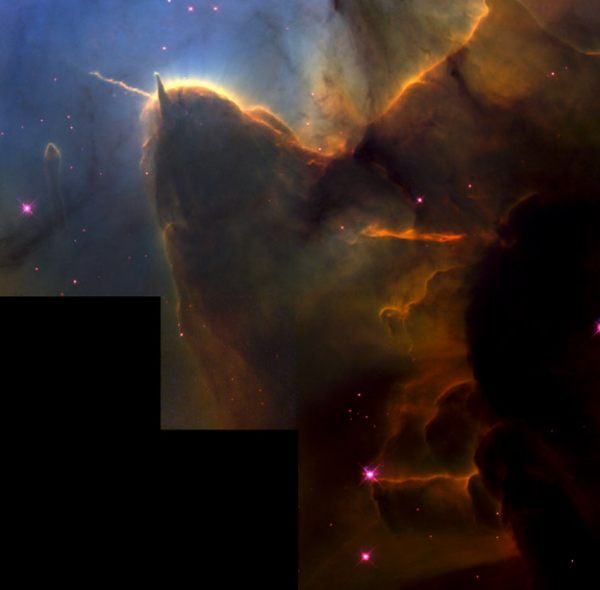
The Trifid Nebula: Stellar Sibling Rivalry

This NASA Hubble Space Telescope image of the Trifid Nebula reveals a stellar nursery being torn apart by radiation from a nearby, massive star. The picture also provides a peek at embryonic stars that are forming within an ill-fated cloud of dust and gas, which is destined to be eaten away by the glare from the massive neighbor. This stellar activity is a beautiful example of how the life cycle of stars like our Sun is intimately connected with their more powerful siblings.
The Hubble image shows a small part of a dense cloud of dust and gas, a stellar nursery full of embryonic stars. This cloud is about 8 light-years away from the nebula's central star, which is beyond the top of this picture. Located about 9,000 light-years from Earth, the Trifid resides in the constellation Sagittarius.
A stellar jet [the thin, wispy object pointing to the upper left] protrudes from the head of a dense cloud and extends three-quarters of a light-year into the nebula. The jet's source is a very young stellar object that lies buried within the cloud. Jets such as this are the exhaust gases of star formation. Radiation from the massive star at the center of the nebula is making the gas in the jet glow, just as it causes the rest of the nebula to glow.
The jet in the Trifid is a "ticker tape," telling the history of one particular young stellar object that is continuing to grow as its gravity draws in gas from its surroundings. But this particular ticker tape will not run for much longer. Within the next 10,000 years the glare of the central, massive star will continue to erode the nebula, overrunning the forming star, and bringing its growth to an abrupt and possibly premature end.
Another nearby star may have already faced this fate. The Hubble picture shows a "stalk" [the finger-like object] pointing from the head of the dense cloud directly toward the star that powers the Trifid. This stalk is a prominent example of the evaporating gaseous globules, or "EGGs," that were seen previously in the Eagle Nebula, another star-forming region photographed by Hubble. The stalk has survived because at its tip there is a knot of gas that is dense enough to resist being eaten away by the powerful radiation.
Reflected starlight at the tip of the EGG may be due to light from the Trifid's central star or from a young stellar object buried within the EGG. Similarly, a tiny spike of emission pointing outward from the EGG looks like a small stellar jet. Hubble astronomers are tentatively interpreting this jet as the last gasp from a star that was cut off from its supply lines 100,000 years ago.
The images were taken Sept. 8, 1997 through filters that isolate emission from hydrogen atoms, ionized sulfur atoms, and doubly ionized oxygen atoms. The images were combined in a single color composite picture. While the resulting picture is not true color, it is suggestive of what a human eye might see.
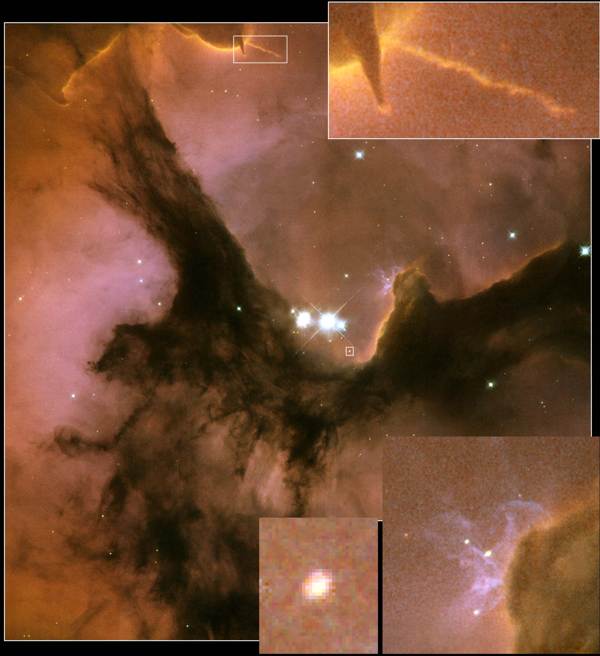
Details in the Heart of the Trifid Nebula
Acknowledgment: F. Yusef-Zadeh (Northwestern Univ.)
Three huge intersecting dark lanes of interstellar dust make the Trifid Nebula one of the most recognizable and striking star birth regions in the night sky. The dust, silhouetted against glowing gas and illuminated by starlight, cradles the bright stars at the heart of the Trifid Nebula. This nebula, also known as Messier 20 and NGC 6514, lies within our own Milky Way Galaxy about 9,000 light-years (2,700 parsecs) from Earth, in the constellation Sagittarius.
This image from the Hubble Space Telescope offers a close-up view of the center of the Trifid Nebula, near the intersection of the dust bands, where a group of recently formed, massive, bright stars is easily visible. These stars, which astronomers classify as belonging to the hottest and bluest types of stars called type "O," are releasing a flood of ultraviolet radiation that dramatically influences the structure and evolution of the surrounding nebula. Many astronomers studying nebulae like the Trifid are focusing their research on the ways that waves of star formation move through such regions.
The group of bright O-type stars at the center of the Trifid illuminates a dense pillar of gas and dust, seen to the right of the center of the image, producing a bright rim on the side facing the stars. At the upper left tip of this pillar, there is a complex filamentary structure. This wispy structure has a bluish color because it is made up of glowing oxygen gas that is evaporating into space.
Star formation is no longer occurring in the immediate vicinity of the conspicuous group of bright O-type stars, because their intense radiation has blown away the gas and dust from which stars are made. However, not far away there are signs of interstellar material collapsing under its own gravity, leading to ongoing star formation. One such example is a very young star that is still surrounded by a ring of gas and dust left over from the star's formation. These circumstellar rings, called protoplanetary disks, or "proplyds" for short, are believed to be the locations where planetary systems are formed. A proplyd in the Trifid Nebula is visible near the lower right of the main Hubble image. An image enlargement of the proplyd is shown in the lower left box, where its elongated shape can be seen.
In the box at upper right, a jet of material is seen being ejected from a very young, low-mass star. The jet, extending to the lower right of the box, protrudes from the head of a dense pillar and extends three-quarters of a light-year out into the surrounding thin gas. The jet's source is a very young stellar object that lies buried within the pillar. Previous Hubble images of the Trifid Nebula, taken in 1997, show very small, but noticeable changes in the knotty material being ejected from this jet. Accompanying the jet is a nearby stalk that points directly toward the central stars in the Trifid Nebula. This finger-like stalk is similar to the large pillars of gas in the well-known Eagle Nebula, also imaged by Hubble.
The Hubble image of the Trifid Nebula has given astronomers insight into the nature of the interaction of gaseous, dusty and stellar material in an area where dust, gas clouds, and new and old stars coexist. The science team, composed of Farhad Yusef-Zadeh (Northwestern U.), John Biretta (STScI), Bob O'Dell (Vanderbilt U.), and Mark Wardle (Macquarie U.), took exposures in filters that transmit light emitted by oxygen, hydrogen, and sulfur ions. The images were taken with the Wide Field Planetary Camera 2 onboard Hubble in mid-summer 2001 and 2002. This image was produced by the Hubble Heritage Team.

Light and Shadow in the Carina Nebula
Previously unseen details of a mysterious, complex structure within the Carina Nebula (NGC 3372) are revealed by this image of the "Keyhole Nebula," obtained with NASA's Hubble Space Telescope. The picture is a montage assembled from four different April 1999 telescope pointings with Hubble's Wide Field Planetary Camera 2, which used six different color filters.
The picture is dominated by a large, approximately circular feature, which is part of the Keyhole Nebula, named in the 19th century by Sir John Herschel. This region, about 8000 light-years from Earth, is located adjacent to the famous explosive variable star Eta Carinae, which lies just outside the field of view toward the upper right. The Carina Nebula also contains several other stars that are among the hottest and most massive known, each about 10 times as hot, and 100 times as massive, as our Sun.
The circular Keyhole structure contains both bright filaments of hot, fluorescing gas, and dark silhouetted clouds of cold molecules and dust, all of which are in rapid, chaotic motion. The high resolution of the Hubble images reveals the relative three-dimensional locations of many of these features, as well as showing numerous small dark globules that may be in the process of collapsing to form new stars.
Two striking large, sharp-edged dust clouds are located near the bottom center and upper left edges of the image. The former is immersed within the ring and the latter is just outside the ring. The pronounced pillars and knobs of the upper left cloud appear to point toward a luminous, massive star located just outside the field further toward the upper left, which may be responsible for illuminating and sculpting them by means of its high-energy radiation and stellar wind of high-velocity ejected material. These large dark clouds may eventually evaporate, or if there are sufficiently dense condensations within them, give birth to small star clusters.
The Carina Nebula, with an overall diameter of more than 200 light-years, is one of the outstanding features of the Southern-Hemisphere portion of the Milky Way. The diameter of the Keyhole ring structure shown here is about 7 light-years.
These data were collected by the Hubble Heritage Team and Nolan R. Walborn (STScI), Rodolfo H. Barba' (La Plata Observatory, Argentina), and Adeline Caulet (France).
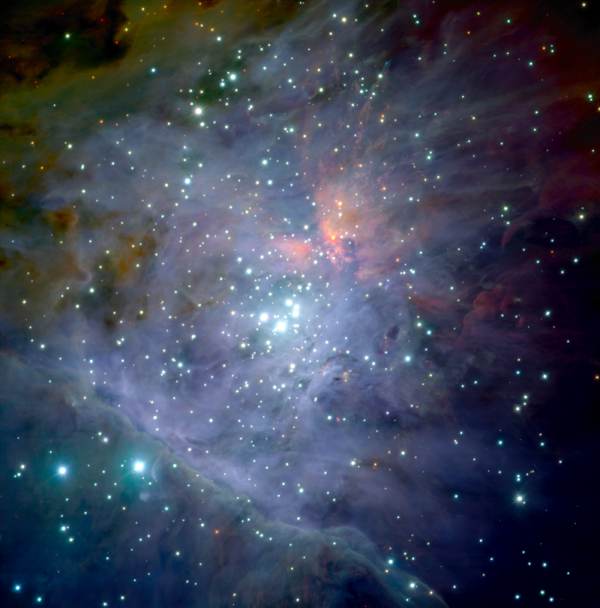
M42, The Orion Nebula
This is a color composite mosaic image of the central part of the Orion Nebula, based on 81 images obtained with the infrared multi-mode ISAAC instrument on the ESO Very Large Telescope (VLT) at the Paranal Observatory. The famous Trapezium stars are seen near the center and the photo also shows the associated cluster of about one thousand stars, about a million years old.
Orion the Hunter is perhaps the best known constellation in the sky, well placed in the evening at this time of the year for observers in both the northern and southern hemispheres, and instantly recognizable. And for astronomers, Orion is surely one of the most important constellations, as it contains one of the nearest and most active stellar nurseries in the Milky Way, the galaxy in which we live.
Here tens of thousands of new stars have formed within the past ten million years or so - a very short span of time in astronomical terms. For comparison: our own Sun is now 4,600 million years old and has not yet reached half-age. Reduced to a human time-scale, star formation in Orion would have been going on for just one month as compared to the Sun's 40 years.
Just below Orion's belt, the hilt of his sword holds a great jewel in the sky, the beautiful Orion Nebula. Bright enough to be seen with the naked eye, a small telescope or even binoculars show the nebula to be a few tens of light-years' wide complex of gas and dust, illuminated by several massive and hot stars at its core, the famous Trapezium stars.
However, the heart of this nebula also conceals a secret from the casual observer. There are in fact about one thousand very young stars about one million years old within the so-called Trapezium Cluster, crowded into a space less than the distance between the Sun and its nearest neighbor stars. The cluster is very hard to observe in visible light, but is clearly seen in the above spectacular image of this area obtained in December 1999 by Mark McCaughrean (Astrophysical Institute Potsdam, Germany) and his collaborators with the infrared multi-mode ISAAC instrument on the ESO Very Large Telescope (VLT) at Paranal (Chile).

A Close-up of the Orion Nebula

This is one of the nearest regions of very recent star formation (300,000 years ago). The nebula is a giant gas cloud illuminated by the brightest of the young hot stars at the top of the picture. Many of the fainter young stars are surrounded by disks of dust and gas that are slightly more than twice the diameter of the Solar System.
The great plume of gas in the lower right in this picture is the result of the ejection of material from a recently formed star. The brightest portions are "hills" on the surface of the nebula, and the long bright bar is where Earth observers look along a long "wall" on a gaseous surface. The diagonal length of the image is 1.6 light-years. Red light depicts emission in Nitrogen; green is Hydrogen; and blue is Oxygen.
The Orion Nebula star-birth region is 1,500 light-years away, in the direction of the constellation Orion the Hunter.
The image was taken on 29 December 1993 with the HST's Wide Field and Planetary Camera 2.

NICMOS Captures the Heart of Omc-1 in the Orion Nebula
WFPC2 image -- C. Robert O'Dell, Shui Kwan Wong (Rice University) and NASA
The infrared vision of the Hubble Space Telescope's Near Infrared Camera and Multi-Object Spectrometer (NICMOS) is providing a dramatic new look at the beautiful Orion Nebula which contains the nearest nursery for massive stars. For comparison, Hubble's Wide Field and Planetary Camera 2 (WFPC2) image on the left shows a large part of the nebula as it appears in visible light. The heart of the giant Orion molecular cloud, OMC-1, is included in the relatively dim and featureless area inside the blue outline near the top of the image. Light from a few foreground stars seen in the WFPC2 image provides only a hint of the many other stars embedded in this dense cloud.
NICMOS's infrared vision reveals a chaotic, active star birth region (as seen in the right-hand image). Here, stars and glowing interstellar dust, heated by and scattering the intense starlight, appear yellow-orange. Emission by excited hydrogen molecules appears blue. The image is oriented with north up and east to the left. The diagonal extent of the image is about 0.4 light-years. Some details are as small as the size of our solar system.
The brightest object in the image is a massive young star called BN (Becklin-Neugebauer). Blue "fingers" of molecular hydrogen emission indicate the presence of violent outflows, probably produced by a young star or stars still embedded in dust (located to the lower left, southeast, of BN). The outflowing material may also produce the crescent-shaped "bow shock" on the edge of a dark feature north of BN and the two bright "arcs" south of BN. The detection of several sets of closely spaced double stars in these observations further demonstrates NICMOS's ability to see fine details not possible from ground-based telescopes.
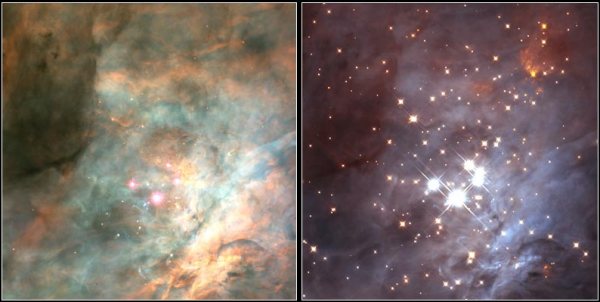
Brown Dwarfs in Orion
Credits for visible-light picture (left): NASA, C.R. O'Dell and S.K. Wong (Rice University)
Probing deep within a neighborhood stellar nursery, NASA's Hubble Space Telescope uncovered a swarm of newborn brown dwarfs. The orbiting observatory's near-infrared camera revealed about 50 of these objects throughout the Orion Nebula's Trapezium cluster [image at right], about 1,500 light-years from Earth.
Appearing like glistening precious stones surrounding a setting of sparkling diamonds, more than 300 fledgling stars and brown dwarfs surround the brightest, most massive stars [center of picture] in Hubble's view of the Trapezium cluster's central region. All of the celestial objects in the Trapezium were born together in this hotbed of star formation. The cluster is named for the trapezoidal alignment of those central massive stars.
Brown dwarfs are gaseous objects with masses so low their cores never become hot enough to fuse hydrogen, the thermonuclear fuel stars like the Sun need to shine steadily. Instead, these gaseous objects fade and cool as they grow older. Brown dwarfs around the age of the Sun (5 billion years old) are very cool and dim, and therefore are difficult for telescopes to find. The brown dwarfs discovered in the Trapezium, however, are youngsters (1 million years old). So they're still hot and bright, and easier to see.
This finding, along with observations from ground-based telescopes, is further evidence that brown dwarfs, once considered exotic objects, are nearly as abundant as stars. The image and results appear in the Sept. 20 issue of the Astrophysical Journal.
The brown dwarfs are too dim to be seen in a visible-light image taken by the Hubble telescope's Wide Field and Planetary Camera 2 [picture at left]. This view also doesn't show the assemblage of infant stars seen in the near-infrared image. That's because the young stars are embedded in dense clouds of dust and gas. The Hubble telescope's near-infrared camera, the Near Infrared Camera and Multi-Object Spectrometer, penetrated those clouds to capture a view of those objects. The brown dwarfs are the faintest objects in the image. Surveying the cluster's central region, the Hubble telescope spied brown dwarfs with masses equaling 10 to 80 Jupiters. Researchers think there may be less massive brown dwarfs that are beyond the limits of Hubble's vision.
The near-infrared image was taken Jan. 17, 1998. Two near-infrared filters were used to obtain information on the colors of the stars at two wavelengths (1.1 and 1.6 microns). The Trapezium picture is 1 light-year across. This composite image was made from a "mosaic" of nine separate, but adjoining images. In this false-color image, blue corresponds to warmer, more massive stars, and red to cooler, less massive stars and brown dwarfs, and stars that are heavily obscured by dust.
The visible-light data were taken in 1994 and 1995.
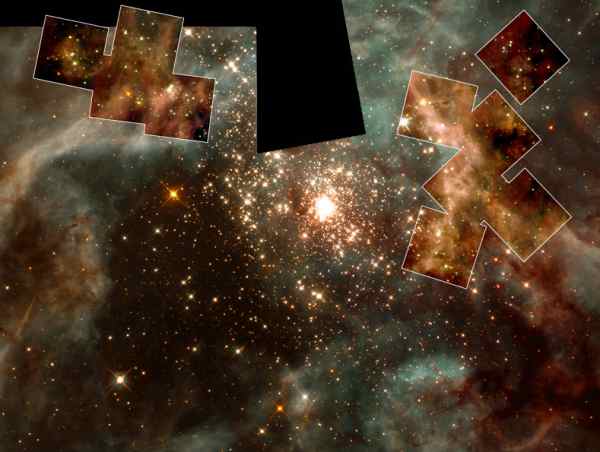
30 Doradus Nebula Montage
A Grand View of the Birth of "Hefty" Stars
Credit for WFPC2 image: NASA/John Trauger (Jet Propulsion Laboratory, Pasadena, Calif.) and James Westphal (California Institute of Technology, Pasadena, Calif.)
This picture, taken in visible light with the Hubble Space Telescope's Wide Field and Planetary Camera 2 (WFPC2), represents a sweeping view of the 30 Doradus Nebula. But Hubble's infrared camera - the Near Infrared Camera and Multi-Object Spectrometer (NICMOS) - has probed deeper into smaller regions of this nebula to unveil the stormy birth of massive stars. The montages of images in the upper left and upper right represent this deeper view. Each square in the montages is 15.5 light-years (19 arcseconds) across.
The brilliant cluster R136, containing dozens of very massive stars, is at the center of this image. The infrared and visible-light views reveal several dust pillars that point toward R136, some with bright stars at their tips. One of them, at left in the visible-light image, resembles a fist with an extended index finger pointing directly at R136. The energetic radiation and high-speed material emitted by the massive stars in R136 are responsible for shaping the pillars and causing the heads of some of them to collapse, forming new stars. The infrared montage at upper left is enlarged in an accompanying image.

30 Doradus Nebula Details
Credit for WFPC2 image: NASA/John Trauger (Jet Propulsion Laboratory, Pasadena, Calif.) and James Westphal (California Institute of Technology, Pasadena, Calif.)
These are two views of a highly active region of star birth located northeast of the central cluster, R136, in 30 Doradus. The orientation and scale are identical for both views. The top panel is a composite of images in two colors taken with the Hubble Space Telescope's visible-light camera, the Wide Field and Planetary Camera 2 (WFPC2). The bottom panel is a composite of pictures taken through three infrared filters with Hubble's Near Infrared Camera and Multi-Object Spectrometer (NICMOS). In both cases the colors of the displays were chosen to correlate with the nebula's and stars' true colors.
Seven very young objects are identified with numbered arrows in the infrared image. Number 1 is a newborn, compact cluster dominated by a triple system of "hefty" stars. It has formed within the head of a massive dust pillar pointing toward R136. The energetic outflows from R136 have shaped the pillar and triggered the collapse of clouds within its summit to form the new stars. The radiation and outflows from these new stars have in turn blown off the top of the pillar, so they can be seen in the visible-light as well as the infrared image.
Numbers 2 and 3 also pinpoint newborn stars or stellar systems inside an adjacent, bright-rimmed pillar, likewise oriented toward R136. These objects are still immersed within their natal dust and can be seen only as very faint, red points in the visible-light image. They are, however, among the brightest objects in the infrared image, since dust does not block infrared light as much as visible light. Thus, numbers 2 and 3 and number 1 correspond respectively to two successive stages in the birth of massive stars. Number 4 is a very red star that has just formed within one of several very compact dust clouds nearby.
Number 5 is another very young triple-star system with a surrounding cluster of fainter stars. They also can be seen in the visible-light picture. Most remarkable are the glowing patches numbered 6 and 7, which astronomers have interpreted as "impact points" produced by twin jets of material slamming into surrounding dust clouds. These "impact points" are perfectly aligned on opposite sides of number 5 (the triple-star system), and each is separated from the star system by about 5 light-years. The jets probably originate from a circumstellar disk around one of the young stars in number 5. They may be rotating counterclockwise, thus producing moving, luminous patches on the surrounding dust, like a searchlight creating spots on clouds. These infrared patches produced by jets from a massive, young star are a new astronomical phenomenon.

Firestorm of Star Birth Seen in a Local Galaxy
Acknowledgment: D. Garnett (U. Arizona), J. Hester (ASU), and J. Westphal (Caltech)
This festively colorful nebula, called NGC 604, is one of the largest known seething cauldrons of star birth in a nearby galaxy. NGC 604 is similar to familiar star-birth regions in our Milky Way galaxy, such as the Orion Nebula, but it is vastly larger in extent and contains many more recently formed stars.
This monstrous star-birth region contains more than 200 brilliant blue stars within a cloud of glowing gases some 1,300 light-years across, nearly 100 times the size of the Orion Nebula. By contrast, the Orion Nebula contains just four bright central stars. The bright stars in NGC 604 are extremely young by astronomical standards, having formed a mere 3 million years ago.
Most of the brightest and hottest stars form a loose cluster located within a cavity near the center of the nebula. Stellar winds from these hot blue stars, along with supernova explosions, are responsible for carving out the hole at the center. The most massive stars in NGC 604 exceed 120 times the mass of our Sun, and their surface temperatures are as hot as 72,000 degrees Fahrenheit (40,000 Kelvin). Ultraviolet radiation floods out from these hot stars, making the surrounding nebular gas fluoresce.
NGC 604 lies in a spiral arm of the nearby galaxy M33, located about 2.7 million light-years away in the direction of the constellation Triangulum. M33, a member of the Local Group of galaxies that also includes the Milky Way and the Andromeda Galaxy, can be seen easily with binoculars. NGC 604 itself can be seen with a small telescope, and was first noted by the English astronomer William Herschel in 1784. Within our Local Group, only the Tarantula Nebula in the Large Magellanic Cloud exceeds NGC 604 in the number of young stars, even though the Tarantula Nebula is slightly smaller in size.
NGC 604 provides Hubble astronomers with a nearby example of a giant star-birth region. Such regions are small-scale versions of more distant "starburst" galaxies, which undergo an extremely high rate of star formation. Starbursts are believed to have been common in the early universe, when the star-formation rate was much higher. Supernovae exploding in these galaxies created the first chemical elements heavier than hydrogen and helium.
The image of NGC 604 was assembled from observations taken with Hubble's Wide Field Planetary Camera 2 in 1994, 1995, and 2001. Color filters were used to isolate light emitted by hydrogen, oxygen, nitrogen, and sulfur atoms in the nebula and ultraviolet, visible and infrared light from the stars within NGC 604 and the nearby spiral arms of M33. Image processors from the Hubble Heritage team at the Space Telescope Science Institute combined these various filter images to create this color picture.
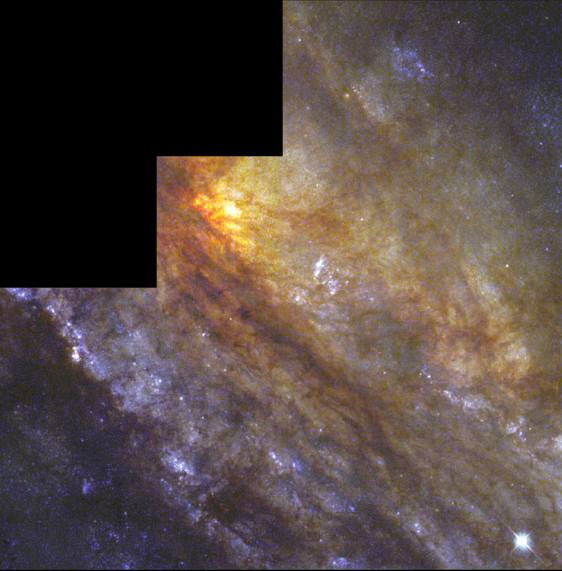
Behind a Dusty Veil Lies a Cradle of Star Birth in NGC 253
NGC 253 is a large, almost edge-on spiral galaxy, and is one of the nearest galaxies beyond our local neighborhood of galaxies. This dramatic galaxy shows complex structures such as clumpy gas clouds, darkened dust lanes, and young, luminous central star clusters. These elements are typical of spiral galaxies. Caroline Herschel discovered NGC 253 in 1783 while looking for comets. The galaxy's closeness to Earth makes it an ideal target for amateur astronomers who can see the southern sky and for astronomers interested in learning more about the makeup of these stunning cities of stars.

Starbirth in NGC 1808
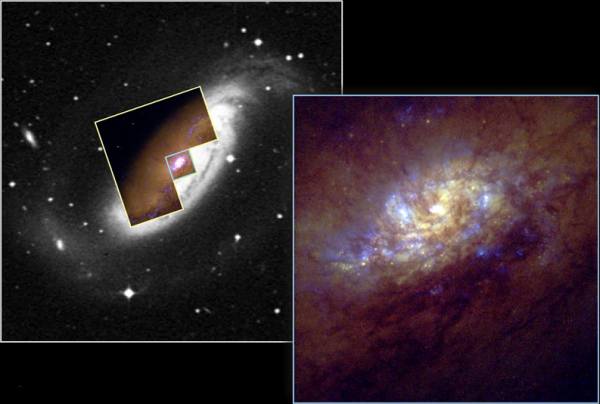
NASA Hubble Space Telescope's Wide Field and Planetary Camera 2 (WFPC2) has captured a flurry of star birth near the heart of the barred spiral galaxy NGC 1808.
On the left are two images, one superimposed over the other. The black-and-white picture is a ground-based view of the entire galaxy. The color inset image, taken with the Hubble telescope's Wide Field and Planetary Camera 2 (WFPC2), provides a close-up view of the galaxy's center, the hotbed of vigorous star formation.
The ground-based image shows that the galaxy has an unusual, warped shape. Most spiral galaxies are flat disks, but this one has curls of dust and gas at its outer spiral arms (upper right-hand corner and lower left-hand corner). This peculiar shape is evidence that NGC 1808 may have had a close interaction with another nearby galaxy, NGC 1792, which is not in the picture Such an interaction could have hurled gas towards the nucleus of NGC 1808, triggering the exceptionally high rate of star birth seen in the WFPC2 inset image.
The WFPC2 inset picture is a composite of images using colored filters that isolate red and infrared light as well as light from glowing hydrogen. The red and infrared light (seen as yellow) highlight older stars, while hydrogen (seen as blue) reveals areas of star birth. Colors were assigned to this false-color image to emphasize the vigorous star formation taking place around the galaxy's center.
NGC 1808 is called a barred spiral galaxy because of the straight lines of star formation on both sides of the bright nucleus. This star formation may have been triggered by the rotation of the bar, or by matter which is streaming along the bar towards the central region (and feeding the star burst).
Filaments of dust are being ejected from the core into a faint halo of stars surrounding the galaxy's disk (towards the upper left corner) by massive stars that have exploded as supernovae in the star burst region. The portion of the galaxy seen in this "wide-field" image is about 35,000 light-years across.
The right-hand image, taken by WFPC2, provides a closer look at the flurry of star birth at the galaxy's core. The star clusters (blue) can be seen (and many more are likely obscured) amid thick lanes of gas and dust. This image shows that stars are often born in compact clusters within star bursts, and that dense gas and dust heavily obscures the star burst region. The brightest knot of star birth seen here is probably a giant cluster of stars, about 100 light-years in diameter, at the very center of the galaxy. The other star clusters are about 10 to 50 light-years in diameter. The entire star burst region shown here is about 3,000 light-years across.
This galaxy is about 40 million light-years away in the southern constellation Columba.
The observation was taken Aug. 14, 1997, and was the last of 13 Hubble Space Telescope amateur programs.
 CosmicLight.com Home
CosmicLight.com Home